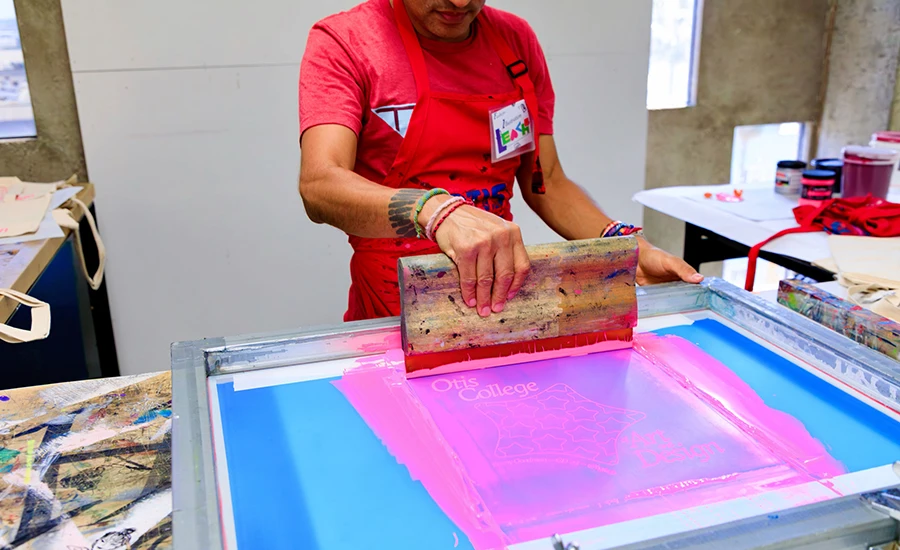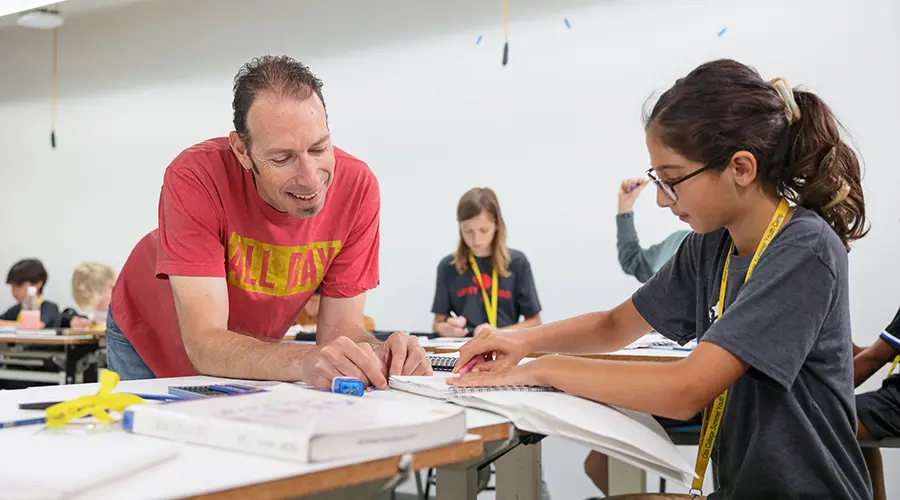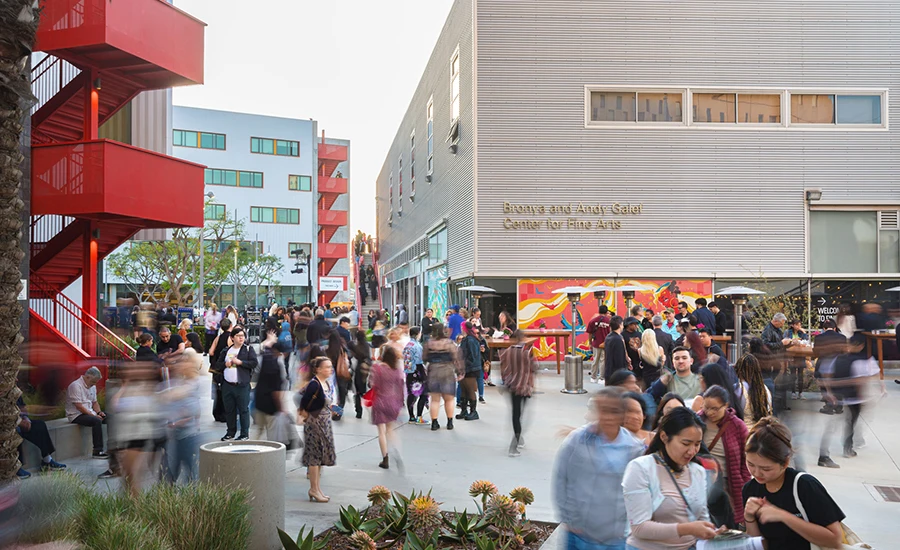An Interview with Brendan Griffiths, the New Chair of Graphic Design and Illustration Programs at Otis College
Griffiths has his sights on more fully preparing Otis graduates for industries impacted by emerging technologies like artificial intelligence.
 Brendan Griffiths recently joined Otis College of Art and Design as Chair of the Graphic Design BFA and MFA programs, as well as the Illustration BFA program.
Brendan Griffiths recently joined Otis College of Art and Design as Chair of the Graphic Design BFA and MFA programs, as well as the Illustration BFA program.
Originally from Eugene, Oregon, Griffiths most recently served as assistant professor of Interaction Design at Parsons School of Design in New York, where he was also the founding director of their Master of Professional Studies in Communication Design. He has led workshops and served as a visiting critic at Yale University, Cranbrook Academy of Art, Hochschule für Gestaltung Offenbach, Pratt Institute, and Harvard Graduate School of Design, and has served on the board of directors of the American Institute of Graphic Arts, New York. Griffiths also is a partner in the design practice ZUT ALORS!, where he’s worked with such clients as Bloomberg, Deitch Projects, The New York Times, The City of New York, Print Magazine, and Johnson & Johnson, among others. He holds a BFA in multimedia design from the University of Oregon and an MFA in graphic design from the Yale School of Art.
Griffiths recently sat down to discuss his goals for the Graphic Design and Illustration programs, the Concept Art emphasis that will soon be offered at the College, and how advances in artificial intelligence will impact the marketplace for Otis graduates: “I envision expanding our curriculum to more deeply integrate emerging technologies while maintaining a strong foundation in traditional skills and processes that we’re already very strong in.”
What attracted you to Otis College and chairing the Graphic Design and Illustration programs?
Otis has always been on my radar as a site of creative innovation, but seeing first-hand the breadth and depth of the work being made here made it an obvious next step for me. The scale and context of what’s happening here is so exciting. The chance to work across these two disciplines—with both graduate and undergraduate students—and the opportunity to think about what’s next for these fields and to do that work with an incredibly diverse student body was essential to me.
How do you imagine evolving the two programs in the coming years?
Generative artificial intelligence is on the top of everyone’s minds at the moment, and both fields are facing some unique challenges, and also opportunities, as the technological landscape of each discipline advances. I envision expanding our curriculum to more deeply integrate emerging technologies while maintaining a strong foundation in traditional skills and processes that we’re already very strong in.
Do you envision interdisciplinary work between the Graphic Design and Illustration majors, or with the other BFA majors at the College?
Absolutely. The Illustration and Graphic Design majors complement each other quite well, and we already have a good number of students in both programs crossing over in their electives.
A graphic designer with strong illustration skills is seen as a unicorn in the market, as is an illustrator who can work with typography, so it’s important that we continue to foster this kind of cross-pollination at a local level."
We’re also on the verge of launching a Concept Art emphasis, which will be jointly offered between the Illustration and Game and Entertainment Design departments and I think will enable some really exciting collaborations between the two programs.
Beyond your background in higher education you are a partner in the design firm ZUT ALORS!. What are some of the most exciting things happening in your practice or in the industry right now?
I’m currently working on custom tools for outputting design assets within a client’s brand guidelines, alongside new ideas for AI interfaces that explore more nuanced ways humans might interact with emerging technologies. I’m also developing a website for a new experimental media gallery set to open this spring in New York.
How will you and other faculty in the Graphic Design and Illustration programs ensure that Otis students are on the cutting edge of these fields?
One of the great things about Otis is that our faculty all have very active professional practices, and we’re all bringing that experience to the classroom and evolving our pedagogy alongside the discipline. We’re also always in dialogue with agencies, technology companies, design studios, and other employers to better understand their needs.
Our focus on professional outcomes is really top of mind as we evolve our curriculum, so understanding where the state-of-the-art is headed for both programs is essential to our process."
What can the Graphic Design and Illustration programs offer a first-year student deciding on their major at Otis?
Both disciplines are rooted in a culture of making and developing a strong facility for communicating ideas visually, and those core skills have become essential in our image-driven culture. I think the best way to understand our community is through the work itself, which you can see in the hallways and classrooms on the sixth floor, and through the vibrant and supportive community that our students have built together. Stop by!
Why is studying graphic design or illustration in Los Angeles so advantageous for Otis students versus New York or other cities?
Los Angeles has one of the most diverse visual landscapes in the world, and being immersed in the rich visual culture of this city presents a unique opportunity for our students to experiment and play in a way that feels less possible in other cities. Access to media, entertainment, and technology here also provides incredible career opportunities for both graphic designers and illustrators as our creative industry expands.
What types of jobs in graphic design or illustration can an Otis College student consider pursuing?
In broad strokes, many of our graphic design students will find work in advertising, branding, user interface design, packaging, environmental design, motion graphics, and editorial. Illustrators work as art directors, animators, storyboard artists, children’s book illustrators, textile and fabric designers, and concept artists.
The trend towards digital outputs marches on, but I also see a resurgence of people starting small companies where they can leverage their design and illustration skills to create and market their own products, which is really exciting.
What do most people not understand about working in graphic design and illustration?
Many people underestimate the strategic thinking and problem-solving skills required in these fields. It’s not just about making things look pretty; it’s about effective visual communication that solves real-world business problems. Most of the work done in both disciplines is client-driven, so understanding how to inhabit the voice of your client and how to speak to a well-defined audience is a big part of the job.
Is there anything else you’d like the Otis Community to know about you?
I’m deeply committed to fostering a diverse and inclusive creative community. I believe great design and illustration can only come from a variety of perspectives and experiences. Towards those ends, I’m fully invested in fostering a community within the department and a real connection to the communities we serve, and I can’t think of a better place to build than at Otis.
More information about the BFA and MFA Graphic Design programs at Otis College. More information about the Illustration BFA program.
Related News



